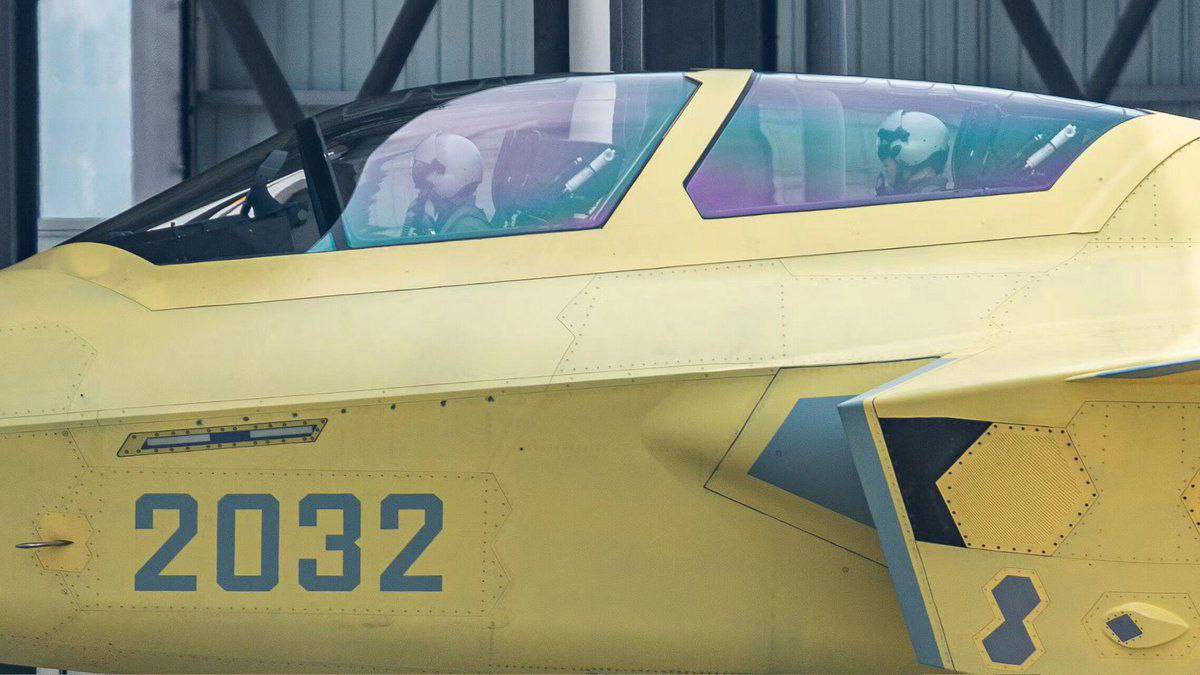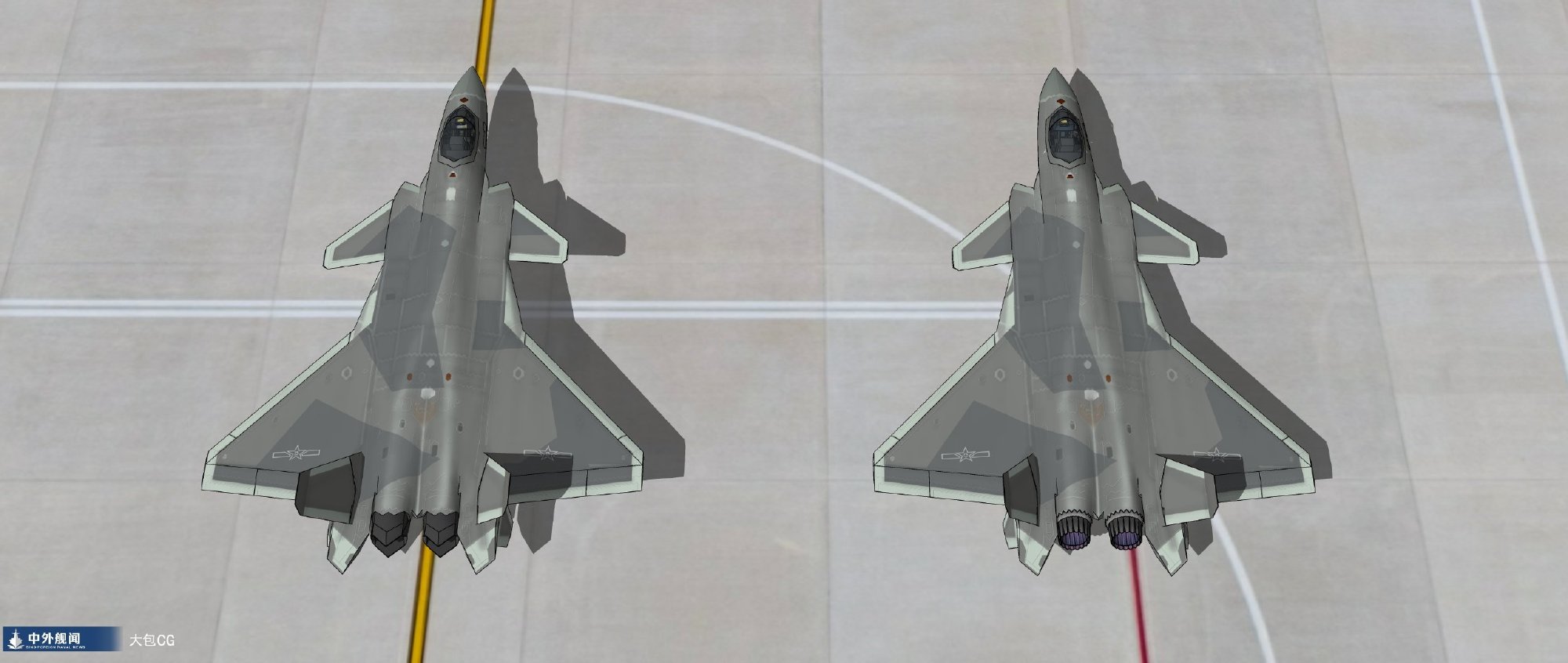Jian 20 Fighter - Chgdu J-20 (Chinese: 歼-20; pinyin: Jiān-Èrlíng) is also known as Mighty Dragon (Chinese: 威龙; pinyin: Wēilóng).
There are three types of aircraft: the initial production model J-20A, the clip-on vector J-20B, and the J-20S capable two-seat aircraft.
Jian 20 Fighter

This makes China the second country in the world and the first country in Asia to produce operational stealth aircraft.
The Life Size Model Of The J 20 Stealth Fighter Aircraft Of Chinese Pla's (people's Liberation Army) Air Force Is Being Built By Chinese Model Airplan Stock Photo
The J-20 evolved from the J-XX program in the late 1990s. In 2008, the PLAAF accepted Chgdu Aerospace Corporation's Project 718 proposal; The plane proposed by Xiang was larger than the J-20.
Chgdu previously used a twin canard configuration on the J-9, the original design of which was discontinued in the 1970s, and the J-10.
In 2009, a senior PLAAF official said that the first flight would take place in 2010–11, with a test period in 2019.
On December 22, 2010, the first J-20 prototype underwent high-speed taxi tests at the Chengdu Aviation Design Institute (CADI).
China's J 20 Stealth Fighter Is Operational
The first prototype was painted with the number "2001". In May 2012, a second prototype flew at the CADI facility.
The third J-20 prototype numbered "2011" made its first flight in March 2014 and underwent several modifications.
The new airframe features modified supersonic intakes (DSI) inlets, a hidden canopy, simplified lower fairings and redesigned vertical stabilizers. Experts noted that new equipment and devices for multi-role operations, such as integrated targets for precision-guided munitions, could include six passive infrared sensors around the aircraft.

In December 2015, military observers saw a low-level initial production (LRIP) version of the J-20.
China's J 20 Carrier Based Jet Fighter Influenced By Us
Previously painted LRIP aircraft for prototypes were found to have dielectric surfaces with various sors or radar-absorbing materials.
In October 2017, Chinese state media reported that the J-20 designs were complete and ready for mass production as well as combat.
In January 2019, Chinese media reported that a two-seat version of the J-20 was rumored to be used in tactical bombing, electronic warfare and carrier strike operations.
In November 2019, defense inspectors spotted a yellow-painted J-20 during a flight test at a China Aerospace Corporation manufacturing plant. The aircraft is equipped with a new type of WS-10 Taihang missiles for stealth.
China Gives 1st Close Up Glimpse Of Cutting Edge Stealth Fighter
Chinese media reported that a new version of the J-20, the J-20B, was launched on July 8, 2020, leading to mass production on the same day. The only change was to equip the J-20B with thrust vector control.
There were conflicting accounts of the exact nature of demons. Analyst Andreas Rupprecht has questioned the use of Russian aircraft in the J-20, as he believes the J-20 will use a variant of the WS-10, known as the WS-10C. This demon has improved emissions, stealth-certified flame nozzles and great reliability, but unlike the WS-10 TVC shown at the 2018 China International Aviation and Aerospace J-10, it is not designed for a launch vector.
Analyst Jamie Hunter believes the new version, called the WShu-10B-3, is a version of the Emission Vector that was launched in China at the 2018 Zhuhai Air Show.

In January 2021, the South China Morning Post reported that China would replace the Russian genes in the J-20 stealth fighter with a Chinese version called the WS-10C.
F 35s Encountered China's J 20: Here's What The Air Force Said About It
In June 2021, Chinese media confirmed that the aviation brigade was designated with the J-20A version, which combines the domestic WS-10C demons.
Despite being a replacement, the WS-10C is considered another stopgap solution before Xian evaluates the WS-15. In addition, the WS-10C will not be equipped with the J-20B, a vectored version of the J-20B that entered mass production in 2019, which still requires further testing. In general, Chinese manufacturers believe that the WS-10C is comparable in performance to the AL-31F,
In January 2021, the Aviation Industry Corporation of China released a computer rendering of a two-seat version of the J-20 fighter jet to mark the 10th anniversary of the aircraft's flight.
In March 2021, a South China Morning Post infographic showed a two-seat J-20 powered by a WS-10C vector.
China Offers First Glimpse Of Chengdu J 20 Stealth Fighter
The two-seat design allows a second operator to coordinate attacks and reconnaissance via a network or unmanned combat aircraft (UCAV) linked to "loyal wing" systems and sensors from other loyal aircraft. Second operator advantage includes the ability to interpret and apply more of the limited cognitive and processing power available to a single person, especially in contested aerial warfare.
In December 2022, Chinese military experts revealed that the WS-15 was in the final stages of testing and development.
At the end of December, a prototype of the new J-20 model was spotted at the facilities of the Chengdu Aerospace Corporation. The new version is painted in Prime Yellow and differs from the previous J-20 in its airframe design, which aims to improve performance and maneuverability for low-altitude, transonic flights. The new WS-15 prototype can be used to test the engine and thrust vectoring.

The J-20 has a long, yellow sail-cut nose and frameless fairing. At the rear of the cockpit are low-profile, variable supersonic input (DSI) inputs. All movable canard surfaces, called bicuspids, are placed behind the inlets, and then the leading edges join the leading edges into a triangular wing. Posteriorly, there are two outwardly projecting carapaces, short but deep ventral striae, and convoluted or poorly visible apertures.
More J 20 Stealth Fighters Built In China
This requires achieving a stable pitch at a high angle of attack, where a conventional backboard loses effectiveness due to stalling. On the other hand, the canard can be deflected from the angle of attack, avoiding stall and thus maintaining control.
The canard design is known for its superior performance, superior level and transonic turning performance, and improved short-field landing compared to delta wing designs.
The leading edges and the rise of the hull are added to the performance in the form of canards. The designer claims this combination provides 1.2 times the lift of a standard canard delta and 1.8 times the lift of a pure delta configuration of the same size. The designer claims that such a combination would reduce high drag and allow the use of a smaller wing without compromising the transonic lift-drag characteristics that are important for the aircraft's turns.
The foam canopy for angle-of-attack control, wide flight control surfaces, and canard configuration indicate that the J-20 is intended to operate in air superiority missions and visual range missions. Chief test pilot Lee Gang describes the J-20 as having significantly better low-observable (LO) performance, with maneuverability comparable to the Chgdu J-10. The J-20 is a versatile air superiority fighter, with the interface role being only one option.
China's First Stealth Jet Looks An Awful Lot Like The Us's First Stealth Fighter — Here's How The J 20 And The F 22 Stack Up
The J-20 aims to provide situational awareness through an advanced air defense system while providing lethality to the adversary through stealth and electronic warfare. The J-20 represents an integrated avionics suite consisting of multi-spectral sources capable of providing comprehensive coverage.
Official information about the type of J-20 radar has not yet been released. Some experts believe that the J-20 used the 1475 (KLJ-5) active electronically scanned array (AESA) radar with transmit/receive modules from 1856,
Other experts estimate that the J-20 may have between 2,000 and 2,200 transceivers based on the J-20's nose section and known data on one transceiver module in the J-16 AESA radar system. .

After 2011, prototypes and production models have an electro-optical/infrared targeting system and an advanced on-board communications suite that can be linked to other platforms in service, such as airspace. early warning drones. The six electro-optical sensors are called split aperture systems
China's J 20 Fighter Jet Put Into Service
(similar to EODAS) can provide comprehensive coverage to the pilot with a ssor fusion system that combines the radar signal with IR imagery for better situational awareness.
The combination of a target mount integrated with a spherical passive-optical tracking system is reported to be similar to the Lockheed Martin F-35 airframe design concept.
Beijing Star Science and Technology has developed the EOTS-86 electro-optical targeting system to detect and intercept stealth aircraft and an electro-optical distributed aperture system for the J-20 and other PLAAF fighters.
The aircraft has an all-digital glass cockpit with one large color liquid crystal display (LCD) touch screen, three small secondary displays and a wide-angle holographic head-up display (HUD).
What Makes China's J 20 Stealth Fighter Such A Problem For The Air Force?
The main LCD screen measures 610 mm × 230 mm (24 in by 9 in), 650 mm (25.63 in) diagonally and has two backlight systems.
The aircraft is equipped with a helmet-mounted display (HMD) system that displays combat data inside the pilots' helmet and high-angle missile launchers.
The main armory is capable of mounting long-range air-to-air missiles (AAM; PL-12, PL-15 to PL-21) and precision-guided munitions (PGM; LS-6/50, LS-6). . / 100),

Two small side guns behind the air intakes are for short-range AAMs (PL-10). These side vents allow the doors to be closed before launching the missile, allowing the missile to be launched stealthily and quickly.
China Surges J 20 Fighter Production: Sets Sights On Surpassing U.s. F 35 & F 22 Airpower
The J-20 does not have an internal autocannon or turret, making the aircraft designed for long-range engagement of missiles such as the PL-15 and PL-21, rather than for use in short-range combat with other aircraft.
The J-20 can carry air-to-air missiles
0 Comments